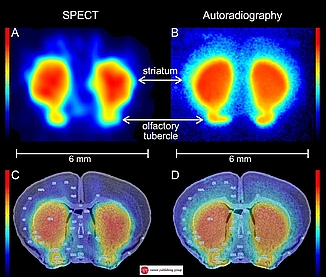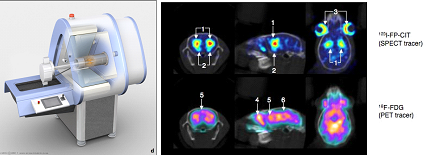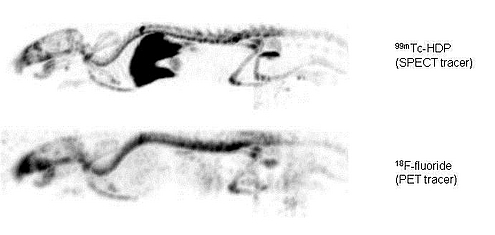Student projects
We often have room for bachelor or master projects. Projects can have strong computational (physics) aspects or be more experimentally oriented. Most of the projects are best suited for physics students and electronics students.
For more information on current projects, please contact Marlies Goorden, M.C.Goorden@tudelft.nl
Biomedical imaging with ultra-high resolution SPECT and PET
Our group develops basic technologies and complete imaging systems that are able to track molecules and cells in living beings. We have been highly successful in developing Single Photon Emission Computed Tomography (SPECT) systems for small animals that provide images of molecular processes in organs and tumors with a world record spatial and temporal resolution (U-SPECT, see Fig. 1). Recently, we have developed a new scanner geometry that can not only image SPECT tracer molecules but is also able to visualize PET (Positron Emission Tomography) tracer molecules at very high resolutions at the same time (VECTor, see Fig. 2). This gives many unique opportunities to develop new pharmaceuticals and biomarkers for treatment and diagnosis of e.g. cancer, brain and cardiac disease. Our SPECT/PET scanner is also equipped with a CT in order to combine the functional information obtained with SPECT/PET with the anatomical information provided by the CT scan.
We conduct research on all aspects of our imaging systems. We improve system geometries by analytical modeling and computer simulations; the most promising new geometries are tested experimentally. We investigate new tomographic image reconstruction algorithms and accurate calibration strategies. Furthermore we improve our gamma-ray detectors by developing our own electronics and by using advanced detection algorithms. Recent interests include the development of clinical scanners with unprecedented resolution and image guided radiation therapy.
Student projects can have strong experimental components or be more computer-programming oriented. If you are interested in working in our group as a bachelor or master student, please contact Dr. Marlies Goorden (tel: 015-2786007) or Prof. dr. Freek Beekman.


Fig. 1A. Molecular images of living mouse with U-SPECT plus verification with autoradiography (right column). B. Movie of drug-interaction acquired with U-SPECT. Vastenhouw et al, Molecular Psychiatry, courtesy Nature Publishing Group.


Figure 2. A. VECTor-CT scanner developed at the research lab of BI. B. Simultaneous mouse brain scan with a PET and a SPECT tracer molecule. C. Simultaneous mouse bone scan with a PET and a SPECT tracer molecule.